The Ostrich is an Ancient Bird
The unofficial capital of the Klein Karoo is Oudtshoorn. Once a small town in the middle of nowhere, Oudtshoorn became a booming metropolis in the early 1900’s thanks to ostrich feathers. The elegant plumage on this distinctly inelegant bird became so popular with stylish European society that, for a short time, ostrich feathers were worth their weight in gold.
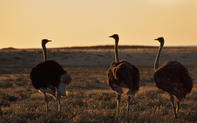
The Ostrich is an ancient bird, thought to originate in Asia perhaps as much as 20 million years ago. They migrated into Africa around a million years ago and spread down the continent, moving about in large, strutting herds. From these wild ostriches came the meat, feathers, leather and unfeasibly large eggs that were prized by early man and Queen Elizabeth alike.
Ironically, it was as a fashion item that the Ostrich became a viable cash crop, and court couturiers of the 17th century liked to use ostrich feathers to decorate hats, dresses and fans. But ostrich feathers weren’t so easy to come by, and early trend-setters, like Marie Antoinette, had to rely on wild ostriches for their supply of plumes.
'Feather' Boom Period
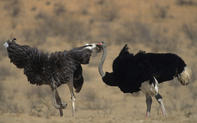
Then, as the middle-class grew, more and more people began aspiring to the fashions of the rich and famous. By the mid 1800’s, graceful ostrich feathers had become de rigueur for the frocks and headdresses of the European bourgeoisie, and prices rose as wild ostrich numbers fell.
So, in order to meet the supply, forward-thinking farmers in Asia, Australia, the Americas and South Africa started breeding tame ostriches. The strategy was a success, and prices rose dramatically as fashionista’s snapped up the feathery crop. With the introduction of wire fencing and Lucerne farming in the 1860’s, ostrich cultivation became an important part of Oudtshoorn’s agricultural output.
The lanky, flightless birds seemed to like the hot, scrubby veld, and the Lucerne fields thrived in the brackish soil. Oudtshoorn was on the way up. The first ‘Feather’ boom period lasted from 1870 to the 1890’s. Then, after a brief lull in the ostrich market, a second boom period got underway at the turn of the century and ran from 1900 to 1914. It was this second boom that really left its mark on the town.
Exporting Ostrich Feathers
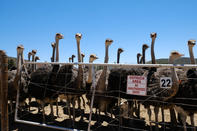
This was the era when ‘Feather Barons’, men who had grown wealthy from their birds’ bumfluff, started building extravagant mansions in town and on their farms. The best furniture and fabrics were imported from Europe, and Oudtshoorn enjoyed a period of absurd prosperity.
While it may sound silly to say that the town prospered because some fat society matrons liked to wear a feather in their caps, it was true. And it was also a very competitive market. In order to stay ahead of their rivals in California and Australia, local farmers decided to get scientific, and sent an expedition to West Africa to track down the rarest and most valuable ostrich on Earth, the wild Barbary ostrich.
The feathers of this thoroughbred bird had the thickest plumes, the most elegant droop and the highest price per kilo. The Barbary was the Rolls-Royce of ostriches, so the South Africans captured several of these birds and began a cross-breeding programme with our local stock. The result was a tame ostrich that grew the ‘Evans’ plume: glossy, strong and curly.
By 1913, South Africa was exporting 450 tonnes of ostrich feathers, worth £3 million annually. At the time, it was South Africa’s fourth most valuable export, after gold, diamonds and wool.
Ostriches Rule the Roost
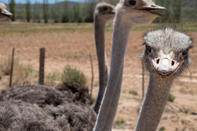
Sadly, the little matter of World War One effectively ended the Ostrich boom. After the horrors of this global conflict, fickle fashions turned away from the flamboyant ostrich feather and reflected a more sombre mood, both socially and economically.
The popularity of motor cars also meant that women had to shift to more restrained head-gear, so that they could step out in their beau’s convertible Model T. Finally, over-production and a badly organised industry couldn’t sustain the high prices, and the whole plucking enterprise collapsed in a feathery heap.
Subsequently, the Feather Palaces were abandoned, and the town of Oudtshoorn began to drift back into its semi-desert somnolence. But ostriches still play a role in the region’s farming. The excellent meat from an Ostrich tastes like steak and is virtually cholesterol-free.
Ostrich leather is hardy and attractive. And what home doesn’t need a feather duster? So, even though many other crops are grown in Oudtshoorn, it is ostriches that still rule the roost.
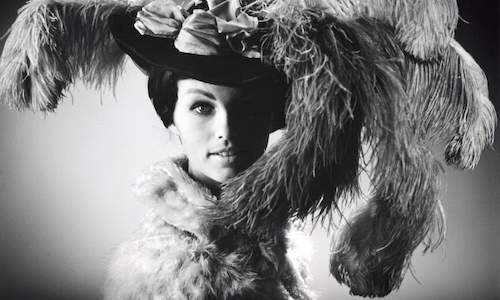 Ostrich farming in South Africa is small compared to the local beef, chicken and pork farming industries, but contributes up to 75% of the w...
Ostrich farming in South Africa is small compared to the local beef, chicken and pork farming industries, but contributes up to 75% of the w...